

Creedmoor Psychiatric Center's Building 25. Abandoned Constanta Casino sits ruined beside the Black Sea. Photo: Gabi Jguma Atlas Obscura on Slate is a blog about the world's hidden wonders.
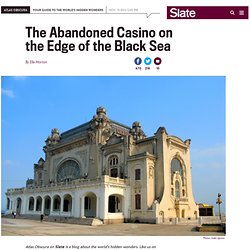
Like us on Facebook, Tumblr, or follow us on Twitter @atlasobscura. From a distance, the Art Nouveau building on a promenade beside the Black Sea looks majestic. As you walk closer, however, Casino Constanta reveals itself: broken windows, curling paint, and rusted railings hint at the dilapidation inside. Photo: Gaspar Serrano Photo: KnitSpirit. Casino Constanta. Originally commissioned by King Carol I around 1900, the Casino first opened to the public in 1910.
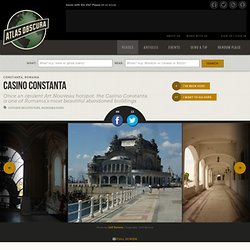
Commanding a dramatic location right on the waterfront of the Black Sea overlooking the ancient port at Constanta, the Casino was a triumph of the Art Nouveau movement, and quickly became the symbol of the city. Worsening circumstances in Romania over the 20th century saw it gradually fall into disrepair, briefly used as a hospital during World War II and eventually repurposed by the communist regime as a restaurant. Maintaining the elaborate structure quickly became prohibitively expensive, and the building was closed in 1990. Despite occasional efforts at restoration, it's remained abandoned ever since. Portrane Lunatic Asylum. In 1895 Portrane Lunatic Asylum was the most expensive building in Ireland paid for by the British Government The hospital had an initial budget of £200,000 but this rose to £300,000 by the time it was finally completed The facility was seen as being at the forefront of mental health care when it was opened in 1903 By Darren Boyle Published: 13:00 GMT, 8 June 2014 | Updated: 15:33 GMT, 8 June 2014.

Abandoned. Packard Automotive Plant. Built between the years 1903 and 1911, Detroit’s Packard Automotive Plant was once considered the most advanced auto production facility of the era.

The complex consists of over 3 million square feet of manufacturing and office space, and it is now one of the largest abandoned buildings in the world. It is so large that from a nearby highway overpass it appears as a great gray streak spanning almost the entire horizon. In person the plant is simply massive: the entire facility sits on over 40 acres, is more than a half mile long, and wider than two football fields. Designed by famous Michigan Architect Albert Khan, the Packard Plant represents an early example of what would become standard Detroit industrial architecture, and came in the early years of what would be a prodigious career for Khan.
He would go on to design buildings for Ford and GM, as well as many for the University of Michigan. Fort Totten. If you look at the MTA Subway map, in the top right hand corner is a legend explaining what the different symbols on the map mean.

But hidden underneath this legend is the location of an abandoned Civil War fort, now an obscure underfunded city park - Fort Totten. Located in the Bayside area of Queens and built in 1862, the fort was designed to protect the approaches to New York by way of the East River from Confederate ships. The fort remained in use until the 1970s and was used as a stockpile for Nike missiles and anti-aircraft batteries. Central Railroad of New Jersey Terminal. Huber Breaker. An abandoned anthracite coal mine that was once at the forefront of American industry, Pennsylvania's Huber Breaker is a symbol of the country's industrial past that is in danger of being turned to scrap.
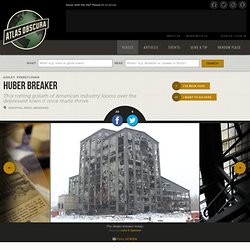
Built in 1938 by the Blue Coal company, the Huber Breaker was the most technologically advanced coal mine of it's time. Standing 11 stories tall at over 130 feet, the massive operation was capable of processing over 1,000 tons of coal an hour, literally breaking large chunks of anthracite coal into household-sized pieces. Wilkes-Barre Abandoned Train Station. The town of Wilkes-Barre, like many small mining settlements, fell into a deep depression when the nearby coal breaker shut down.
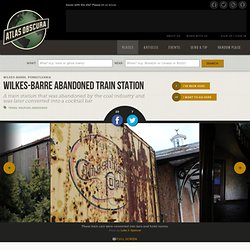
However its single train station hung on as a cocktail bar until it too was abandoned. Wilkes-Barre was once a thriving coal mining town in Eastern Pennsylvania but once the mines shut down in the 1970s, the town was been left to gather dust. Box Hill Brick Works. The Box Hill Brickworks is an abandoned brick-making facility that is a wonderland of rusting gears and street art.

Originally built around the 1880's, the large brickworks intermittently produced builder's bricks for almost 100 years until finally being abandoned in 1988. The plant's smokestack has become a staple of the Box Hill skyline, and the state government even declared the works a heritage preservation site, although this has not led to any active preservation. The remaining machinery, molds, and kiln have become a playground for urban explorers and graffiti artists. In the years since its closing, almost every surface of the interior has been covered with graffiti. Kennal Vale Gunpowder Works. Miami Marine Stadium. Built in 1963, the Miami Marine Stadium took advantage of a beautiful view of downtown Miami and a passing speedboat trend, but now the world's first boat racing stadium is now an abandoned maze of vandalized cement.

When the Miami Marine Stadium opened it seemed like a great fit for the seaside city that already had a strong relationship with boats and water sports. A Photographer Finds the Ghost of Woody Guthrie in an Abandoned Asylum. Inside Greystone Hospital (photograph by Phillip Buehler) In the legend of folk icon Woody Guthrie, his final 15 years as a hospital patient tormented by Huntington's Disease are often forgotten.
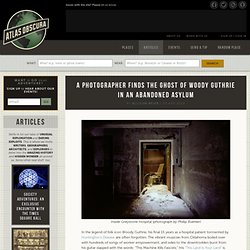
The vibrant musician from Oklahoma boiled over with hundreds of songs of worker empowerment, and odes to the downtrodden burst from his guitar slapped with the words: "This Machine Kills Fascists. " His "This Land Is Your Land" is practically an alternative populist national anthem. Yet his final years are also a part of who he was, even as his mental and physical abilities deteriorated with the degenerative hereditary disease so that he couldn't even hold a guitar. Photographer Phillip Buehler set out to document the abandoned Greystone Park Psychiatric Hospital in Morris Plains, New Jersey, where Guthrie was a patient from 1956 to 1961.
An Abandoned Cinema in the Egyptian Desert Where the Only Show Is Sunset. The Sinai cinema in 2011 (photograph by Derek Cave) Hang a left off the highway asphalt near Sharm el-Sheikh, turn away from the warm sea lapping against Egypt's Sinai Peninsula, and head into the desert hills. Now you’re on sand packed from the wheels of a million four-wheel motorbikes — transport for tourists who may never see what you'll see. Cross a wash of grey-brown dust, hang another left, but don't go too far. You'll miss the movie.
The desert, open-air cinema stretches before you with row after row of wooden seats — 700 of them — each with painted designs, rising at a reasonable rate to what looks like a projection house. Abandoned Berlin. Heilstätten Hohenlychen (all photographs courtesy the author/Abandoned Berlin) Berlin and its surrounding areas play host to a multitude of discarded, unwanted, or unloved deserted buildings. Most are hidden, others are sealed, with their secrets locked up and kept forever more. Or so they think. At Abandoned Berlin, we document the German capital’s derelict sites, their histories, and the tall tales behind each one. Here are five ruins the city’s authorities would rather you didn’t know about. Abandoned Illinois Soldiers’ and Sailors’ Children’s School. Opened in 1865 as the Civil War Orphans' Home, this school complex was originally built as a boarding school for children of Civil War veterans.
Children of veterans from other wars were later admitted, and eventually it was opened up to all orphans. Severalls Asylum. Built in 1910, this co-ed asylum was a beautifully ornate building designed by architect Frank Whitmore, and a nightmare of experimental psychiatry for patients. Jardin d'Agronomie Tropicale: Ruins of a Human Zoo at the Forgotten Edge of Paris.
Ballhaus Riviera.